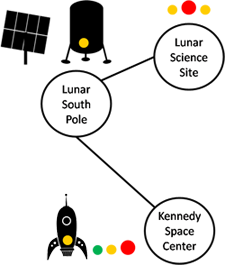SpaceNet Concepts
NodesNodes represent static locations either on the surface of planetary bodies or in space (stable orbits and Lagrange points). Nodes are often given three- or four-letter designations similar to airport codes. Some examples of nodes may include:
|
Time-Expanded NetworkElements and resources move between nodes during simulation through a time-expanded network. Edges correspond to transportation methods including impulsive rocket burns, surface-to-surface paths for surface elements, and abstracted flights for notional carriers. Edges connecting nodes may only be available at certain times corresponding to favorable orbital dynamics. Some examples of edges may include:
|
ElementsElements are unique entities that move between various nodes and form the basis of a SpaceNet simulation. Elements may generate demands for resources during a simulation. There are many different specialized types of elements, ranging from surface vehicles, propulsive vehicles, carriers (able to carry crew and/or cargo), resource containers (able to carry resources), and crew members. Some examples of elements may include:
|
ResourcesResources are non-unique commodity types that exist in set quantities during simulation. There are three main classes of resources: continuous, discrete, and generic (notional representation for abstracted resources treated as continuous). As elements produce or demand resources, the quantities of resources available inside containers and aggregated levels available at a node will change. Some examples of resources may include:
|
EventsEvents drive the simulation by issuing commands to move elements throughout the time-expended network and directing consumption and production or resources. Seven core events are used at the lowest level (create, move, and remove elements; add, transfer, and use resources; reconfigure elements) and event compositions are used to handle more complex interactions such as transportation along edges and exploration at a node. Some examples of events may include:
|

The building blocks of SpaceNet
|

